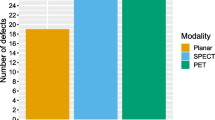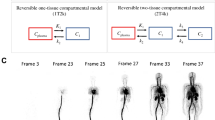Abstract
Purpose
Widely used in clinical practice, the maximum standardized uptake value (SUVmax) is a statistical index highly prone to physical and biological variations, which can lead to unpredictable errors. This study has a methodological aim: to identify a more robust SUV-based index representing the tracer accumulation. In particular, the new metric was tested to confirm the potential of mannitol to reduce renal uptake Ga-68 prostate-specific membrane antigen ([68Ga]PSMA).
Procedures
To this aim, our previously published work, proving the efficacy of mannitol, was considered as a background study. Renal SUVmax was calculated in nine patients undergoing [68Ga]PSMA positron emission tomography (PET)/X-ray computed tomography (CT) at baseline (b-PET/CT) and at follow-up after intravenous infusion of 500 ml of 10 % mannitol (m-PET/CT). SUV values of kidney volumes were extracted by a new 3D segmentation method. A new parameter, the median computed on the upper 10% of the SUV distribution (SUV95th), was introduced to better characterize the tracer accumulation. A comparison between SUVmax and SUV95th was also performed. Kruskal-Wallis test was used to assess the statistical significance of the differences in SUV95th between b-PET/CT and m-PET/CT.
Results
SUV95th not only confirmed the efficacy of mannitol as demonstrated in the previous study but improved the separability of b-PET/CT and m-PET/CT examinations, overturning SUVmax findings in two cases. The outcomes of the Kruskal-Wallis test computed for each kidney proved that differences between b-PET/CT and m-PET/CT SUV95th values were significant (p value < 0.001).
Conclusions
Our findings indicate that SUV95th is a more robust index to assess high uptake level, representing a reliable alternative to SUVmax. Independently from the segmentation method, the superiority of SUV95th and its easy computation could make its clinical impact decisive. The results obtained with SUV95th, more representative of tracer uptake than those with SUVmax suggest, in our opinion, that mannitol infusion could be used to reduce the adsorbed dose to the kidneys during [68Ga]PSMA PET/CT and Lu-177 or Ac-225 therapy. Our future goal will be confirming this effect in a larger cohort of patients, also verifying the role of SUV95th in the evaluation of tumor response to therapy.





Similar content being viewed by others
References
Afshar-Oromieh A, Avtzi E, Giesel FL, Holland-Letz T, Linhart HG, Eder M, Eisenhut M, Boxler S, Hadaschik BA, Kratochwil C, Weichert W, Kopka K, Debus J, Haberkorn U (2015) The diagnostic value of PET/CT imaging with the 68 Ga-labelled PSMA ligand HBED-CC in the diagnosis of recurrent prostate cancer. Eur J Nucl Med Mol Imaging 42:197–209
Han S, Woo S, Kim YJ, Suh CH (2018) Impact of 68Ga-PSMA PET on the Management of patients with prostate cancer: a systematic review and meta-analysis. Eur Urol 74:179–190
Afshar-Oromieh A, Zechmann CM, Malcher A, Eder M, Eisenhut M, Linhart HG, Holland-Letz T, Hadaschik BA, Giesel FL, Debus J, Haberkorn U (2014) Comparison of PET imaging with a 68 Ga-labelled PSMA ligand and 18 F-choline-based PET/CT for the diagnosis of recurrent prostate cancer. Eur J Nucl Med Mol Imaging 41:11–20
Mannweiler S, Amersdorfer P, Trajanoski S, Terrett JA, King D, Mehes G (2009) Heterogeneity of prostate-specific membrane antigen (PSMA) expression in prostate carcinoma with distant metastasis. Pathol Oncol Res 15:167–172
Baccala A, Sercia L, Li J, Heston W, Zhou M (2007) Expression of prostate-specific membrane antigen in tumor-associated neovasculature of renal neoplasms. Urology 70:385–390
Matteucci F, Mezzenga E, Caroli P, di Iorio V, Sarnelli A, Celli M, Fantini L, Moretti A, Galassi R, de Giorgi U, Paganelli G (2017) Reduction of 68Ga-PSMA renal uptake with mannitol infusion: preliminary results. Eur J Nucl Med Mol Imaging 44:2189–2194
Sarnelli A, Belli ML, Di Iorio V et al (2019) Dosimetry of 177Lu-PSMA-617 after Mannitol Infusion and Glutamate. Molecules 24:621
Schneider CA, Rasband WS, Eliceiri KW (2012) NIH Image to ImageJ: 25 years of image analysis. Nat Methods 9:671
Bolte S, Cordelieres FP (2006) A guided tour into subcellular colocalization analysis in light microscopy. J Microsc 224:213–232
Ollion J, Cochennec J, Loll F, Escudé C, Boudier T (2013) TANGO: a generic tool for high-throughput 3D image analysis for studying nuclear organization. Bioinformatics 29:1840–1841
Schwertman NC, Owens MA, Adnan R (2004) A simple more general boxplot method for identifying outliers. Comput Stat Data Anal 47:165–174
Okamoto S, Thieme A, Allmann J, D'Alessandria C, Maurer T, Retz M, Tauber R, Heck MM, Wester HJ, Tamaki N, Fendler WP, Herrmann K, Pfob CH, Scheidhauer K, Schwaiger M, Ziegler S, Eiber M (2017) Radiation dosimetry for 177Lu-PSMA I&T in metastatic castration-resistant prostate cancer: absorbed dose in normal organs and tumor lesions. J Nucl Med 58:445–450
Hohberg M, Kobe C, Täger P, Hammes J, Schmidt M, Dietlein F, Wild M, Heidenreich A, Drzezga A, Dietlein M (2019) Combined early and late [68Ga]PSMA-HBED-CC PET scans improve lesion detectability in biochemical recurrence of prostate cancer with low PSA levels. Mol Imaging Biol 21:558–566
Lodge MA, Chaudhry MA, Wahl RL (2012) Noise considerations for PET quantification using maximum and peak standardized uptake value. J Nucl Med 53:1041
Soret M, Bacharach SL, Buvat I (2007) Partial-volume effect in PET tumor imaging. J Nucl Med 48:932
Ziai P, Hayeri MR, Salei A, Salavati A, Houshmand S, Alavi A, Teytelboym OM (2016) Role of optimal quantification of FDG PET imaging in the clinical practice of radiology. Radiographics 36:481–496
Kang SY, Cheon GJ, Lee M, Kim HS, Kim JW, Park NH, Song YS, Chung HH (2017) Prediction of recurrence by preoperative intratumoral FDG uptake heterogeneity in endometrioid endometrial cancer. Transl Oncol 10:178–183
Adams MC, Turkington TG, Wilson JM, Wong TZ (2010) A systematic review of the factors affecting accuracy of SUV measurements. Am J Roentgenol 195:310–320
Lim RS, Ramdave S, Beech P et al (2016) Utility of SUV max on 18 F-FDG PET in detecting cervical nodal metastases. Cancer Imaging 16:39
Acknowledgments
The authors would like to thank Filippo Piccinini for his help with data collection during the starting stage of this study.
Funding
This research was partially supported by the Italian Ministry of Health (grant RF-2016-02364230), and by the Italian Association for Cancer Research (AIRC), (grant IG 20476).
Author information
Authors and Affiliations
Contributions
Study concept and design: AS, AB, SB.
Provision of study materials or patients: FM, AS, EM.
Collection and assembly of data: FM.
Radiopharmaceutical synthesis and quality control: VDI.
Diagnostic imaging: FM, PC.
Analysis and interpretation of data: SB, AB, AS.
Drafting of manuscript: SB.
Critical revision of the manuscript for important intellectual content: GP, AB, FM, AS.
All authors read and approved the final manuscript for submission.
Corresponding author
Ethics declarations
Ethical Approval
The protocol was approved by the Ethics Committee of Area Vasta Romagna and by the competent Italian regulatory authorities. The study was performed in accordance with the principles of the Declaration of Helsinki and Good Clinical Practice.
Informed Consent
All patients gave their written informed consent.
Conflict of Interest
The authors declare that they have no conflict of interest.
Additional information
Publisher’s Note
Springer Nature remains neutral with regard to jurisdictional claims in published maps and institutional affiliations.
Rights and permissions
About this article
Cite this article
Baiocco, S., Matteucci, F., Mezzenga, E. et al. SUV95th as a Reliable Alternative to SUVmax for Determining Renal Uptake in [68Ga] PSMA PET/CT. Mol Imaging Biol 22, 1070–1077 (2020). https://doi.org/10.1007/s11307-019-01451-1
Published:
Issue Date:
DOI: https://doi.org/10.1007/s11307-019-01451-1




